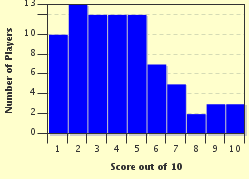Quiz Answer Key and Fun Facts
1. Which of the following scales does NOT contain both F# and G?
2. Three of these modal scales have the same notes in them. One does not. Which is the odd one out?
3. Which of the following scales could be effectively used for improvisation over this chord progression: Cm|Bb|Dm|Eb|Cm||
4. A song is written in A and the last two bars are: |E|A||. What type of cadence is that ?
5. Which of the following is the chord spelling for Gbm7(b5)?
6. Which of the following is the spelling of a blues scale ?
7. How many major scales are there that have both of the notes E# and F# ?
8. Which of the following chords should be on the fifth degree of F# harmonic minor scale?
9. What does this notation mean: Dmaj7/A
10. How many unique pitch combinations can result in an augmented triad?
Source: Author
S1LentK1LleR
This quiz was reviewed by FunTrivia editor
ertrum before going online.
Any errors found in FunTrivia content are routinely corrected through our feedback system.

